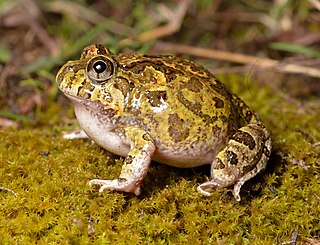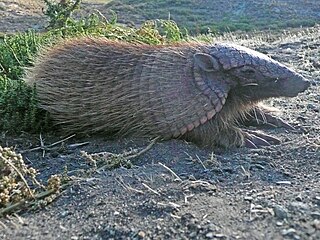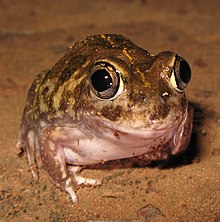
The greater bilby, or simply bilby, is a long-eared, rabbit-like mammal native to Australia. It lives in burrows and is active at night, feeding on insects, fruit, or fungi. The bilby is a marsupial and carries its young in a pouch. Threats include habitat loss, disease, and introduced predators such as foxes. Formerly widespread, bilbies are now restricted to arid parts of northwestern and central Australia.

Antaresia is a genus of pythons, nonvenomous snakes in the family Pythonidae. The genus is native to Australasia. The genus is known by the common name Children's pythons, the name of the type species, Antaresia childreni. Gray named A. childreni in honour of his mentor, John George Children, who was a curator of the zoological collection at the British Museum around that time. It contains the smallest members of the Pythonidae. Four species and two subspecies are recognized, although they were all considered part of the same species until recently. A newly described form called the pygmy banded python may be a distinct species, but analysis has not yet been performed on this animal. The largest recorded examples of Antaresia species have all been males, suggesting males of the known species in this genus may compete for females. This behavior has never been witnessed in the wild, and has only been witnessed in captive specimens.

Mulgaras are the two small rat-sized species in the genus Dasycercus. They are marsupial carnivores, closely related to the Tasmanian devil and the quolls, that live in deserts and spinifex grasslands of arid Australia. They are nocturnal, but occasionally "sunbathe" in the entrance of the burrow in which they dwell. Their kidneys are highly developed to excrete extremely concentrated urine to preserve water, as the animals rarely drink. They feed mostly on insects, but also eat reptiles and small mammals. They are seasonal breeders and breed from June to September. The pouch comprises two lateral folds of skin.

Limnodynastes dumerilii is a frog species from the family Limnodynastidae. The informal names for the species and its subspecies include eastern or southern banjo frog, and bull frog. The frog is also called the pobblebonk after its distinctive "bonk" call, which is likened to a banjo string being plucked. There are five subspecies of L. dumerilii, each with different skin coloration. The species is native to eastern Australia. There has been one occurrence in New Zealand, when tadpoles of the species were found in 1999 and destroyed.

Breviceps is a genus of frogs in the family Brevicipitidae. Species in the genus Breviceps are commonly known as rain frogs or short-headed frogs. They occur in arid to semiarid climates of Eastern and Southern Africa.

The ornate burrowing frog is a species of ground frog native to Australia. It was moved to the genus Opisthodon in 2006, following a major revision of amphibians, and is now classified in the genus Platyplectrum.

The Sudell's frog, painted burrowing frog, trilling frog or desert trilling frog is a species of burrowing frog common to a large part of southeastern Australia. It is found on and west of the Great Dividing Range of New South Wales to western Victoria and southern Queensland, as well as far eastern South Australia, and southern regions of the Northern Territory.
Ranoidea vagitus, the wailing frog, is a species of tree frog occupying the arid and monsoonal Kimberley region. It is a ground dweller, which evades dry periods by burrowing and hibernating - emerging to breed during floods.
The inland forest bat is a vesper bat that occurs in central and arid regions in Australia. They were first described in 1987, published in a review of poorly surveyed microbat populations. A tiny flying mammal, it occupies small cavities in trees and buildings while roosting. The nocturnal activity is foraging for insects, typically moths.
Finlayson's cave bat is a species of vesper bat found only in Australia.

The giant banjo frog, giant pobblebonk frog, giant bullfrog, or great bullfrog is a species of frog, endemic to Australia, in the family Limnodynastidae. Fry was the first to recognise the species of Giant Banjo Frog as a distinct subspecies of Banjo Frog, differing from the similar Southern or Eastern Banjo Frogs which occupied most of eastern Australia.

The humming frog is a species of frog in the family Limnodynastidae. It is endemic to Australia. Its natural habitats are temperate forests, temperate shrubland, Mediterranean-type shrubby vegetation, intermittent freshwater marshes, rocky areas, arable land, pastureland and open excavations.

The desert spadefoot toad is a species of frog in the family Limnodynastidae. It is endemic to Australia. Its natural habitats are subtropical or tropical dry shrubland, subtropical or tropical dry lowland grassland, intermittent freshwater marshes, hot deserts, and temperate desert.
Paroplocephalus is a genus of venomous snake in the family Elapidae. The genus is monotypic, containing only the species Paroplocephalus atriceps, the Lake Cronin snake. The species is endemic to western Australia.

The screaming hairy armadillo is a species of armadillo also known as the small screaming armadillo, crying armadillo or the small hairy armadillo. It is a burrowing armadillo found in the central and southern parts of South America. The adjective "screaming" derives from its habit of squealing when handled.

Morelia imbricata is a large snake found in southern regions of Western Australia and western South Australia. A member of the python family, it is commonly known as the southwestern carpet python.

The curl snake is a species of venomous, heavily built snake in the family Elapidae. The species, which is native to Australia, is also known more commonly in Western Australia as the myall snake. The curl snake is often confused with a similar species named the Ord curl snake.

Eucteniza is a genus of trapdoor spiders in the family Euctenizidae containing at least 14 species occurring in Mexico and the southern United States. Species are distinguished by a softened rear portion of the carapace, and males possess large spines on the first two pairs of walking legs that are used to hold females during mating. Like other trapdoor spiders they create burrows with a hinged lid, from which they await passing insects and other arthropods to prey upon. Many species are known from only one or two localities, or from only male specimens. More species are expected to be discovered. Eucteniza is closely related to spiders of the genera Entychides and Neoapachella.
The gibber earless dragon also known as the smooth-snouted earless dragon, is a species of agamid lizard endemic to Australia. It is one of a documented species of the genus Tympanocryptis, a group of small terrestrial lizards that feed off invertebrates and are characterised by the absence of an external ear structure.

Platyplectrum is a genus of ground-dwelling frog in the family Limnodynastidae. Species in this genus are found in Australia, New Guinea, and on the Aru Islands. They are medium-sized frogs and the dorsal skin has a sandpaper-like texture.
















